BMW ACTIVE HYBRID 5 2014 F10H Owner's Manual
Manufacturer: BMW, Model Year: 2014, Model line: ACTIVE HYBRID 5, Model: BMW ACTIVE HYBRID 5 2014 F10HPages: 251, PDF Size: 5.36 MB
Page 231 of 251
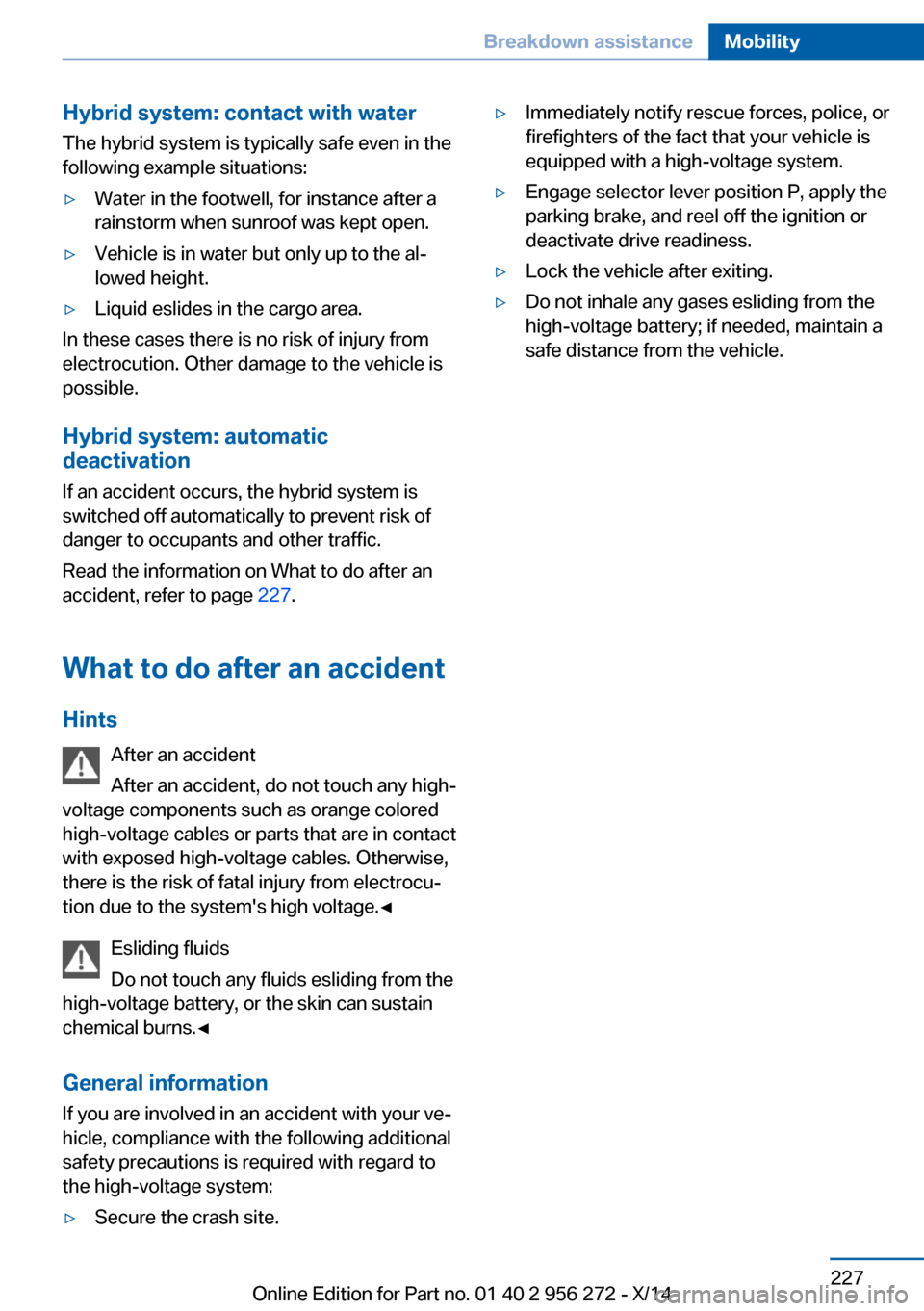
Hybrid system: contact with water
The hybrid system is typically safe even in the
following example situations:▷Water in the footwell, for instance after a
rainstorm when sunroof was kept open.▷Vehicle is in water but only up to the al‐
lowed height.▷Liquid eslides in the cargo area.
In these cases there is no risk of injury from
electrocution. Other damage to the vehicle is
possible.
Hybrid system: automatic
deactivation
If an accident occurs, the hybrid system is
switched off automatically to prevent risk of
danger to occupants and other traffic.
Read the information on What to do after an
accident, refer to page 227.
What to do after an accident Hints After an accident
After an accident, do not touch any high-
voltage components such as orange colored
high-voltage cables or parts that are in contact
with exposed high-voltage cables. Otherwise,
there is the risk of fatal injury from electrocu‐
tion due to the system's high voltage.◀
Esliding fluids
Do not touch any fluids esliding from the
high-voltage battery, or the skin can sustain
chemical burns.◀
General information
If you are involved in an accident with your ve‐
hicle, compliance with the following additional
safety precautions is required with regard to
the high-voltage system:
▷Secure the crash site.▷Immediately notify rescue forces, police, or
firefighters of the fact that your vehicle is
equipped with a high-voltage system.▷Engage selector lever position P, apply the
parking brake, and reel off the ignition or
deactivate drive readiness.▷Lock the vehicle after exiting.▷Do not inhale any gases esliding from the
high-voltage battery; if needed, maintain a
safe distance from the vehicle.Seite 227Breakdown assistanceMobility227
Online Edition for Part no. 01 40 2 956 272 - X/14
Page 232 of 251
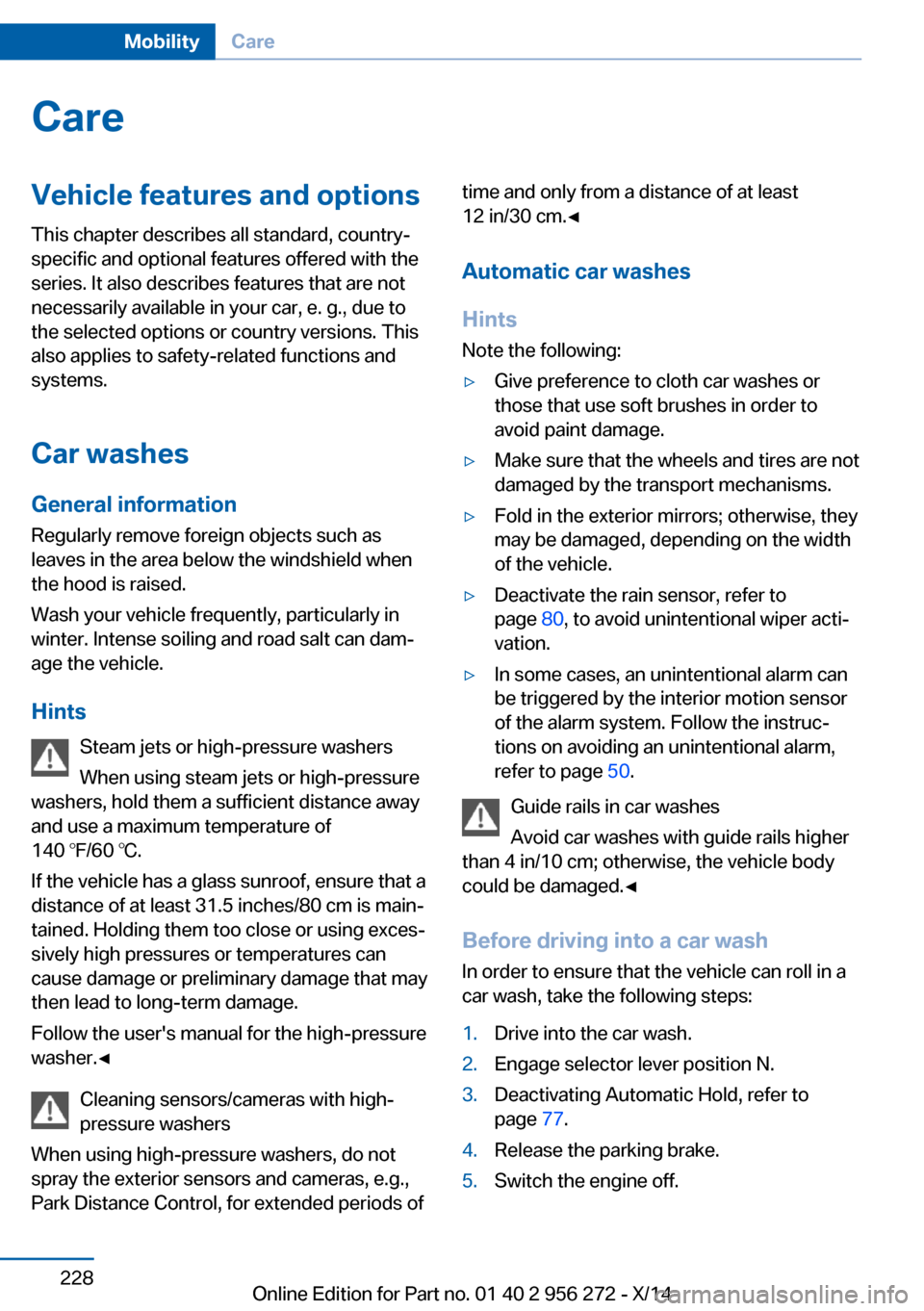
CareVehicle features and optionsThis chapter describes all standard, country-
specific and optional features offered with the
series. It also describes features that are not
necessarily available in your car, e. g., due to
the selected options or country versions. This
also applies to safety-related functions and
systems.
Car washes
General information
Regularly remove foreign objects such as
leaves in the area below the windshield when
the hood is raised.
Wash your vehicle frequently, particularly in
winter. Intense soiling and road salt can dam‐
age the vehicle.
Hints Steam jets or high-pressure washers
When using steam jets or high-pressure
washers, hold them a sufficient distance away
and use a maximum temperature of
140 ℉/60 ℃.
If the vehicle has a glass sunroof, ensure that a
distance of at least 31.5 inches/80 cm is main‐
tained. Holding them too close or using exces‐
sively high pressures or temperatures can
cause damage or preliminary damage that may
then lead to long-term damage.
Follow the user's manual for the high-pressure
washer.◀
Cleaning sensors/cameras with high-
pressure washers
When using high-pressure washers, do not
spray the exterior sensors and cameras, e.g.,
Park Distance Control, for extended periods oftime and only from a distance of at least
12 in/30 cm.◀
Automatic car washes
Hints Note the following:▷Give preference to cloth car washes or
those that use soft brushes in order to
avoid paint damage.▷Make sure that the wheels and tires are not
damaged by the transport mechanisms.▷Fold in the exterior mirrors; otherwise, they
may be damaged, depending on the width
of the vehicle.▷Deactivate the rain sensor, refer to
page 80, to avoid unintentional wiper acti‐
vation.▷In some cases, an unintentional alarm can
be triggered by the interior motion sensor
of the alarm system. Follow the instruc‐
tions on avoiding an unintentional alarm,
refer to page 50.
Guide rails in car washes
Avoid car washes with guide rails higher
than 4 in/10 cm; otherwise, the vehicle body
could be damaged.◀
Before driving into a car wash In order to ensure that the vehicle can roll in a
car wash, take the following steps:
1.Drive into the car wash.2.Engage selector lever position N.3.Deactivating Automatic Hold, refer to
page 77.4.Release the parking brake.5.Switch the engine off.Seite 228MobilityCare228
Online Edition for Part no. 01 40 2 956 272 - X/14
Page 233 of 251
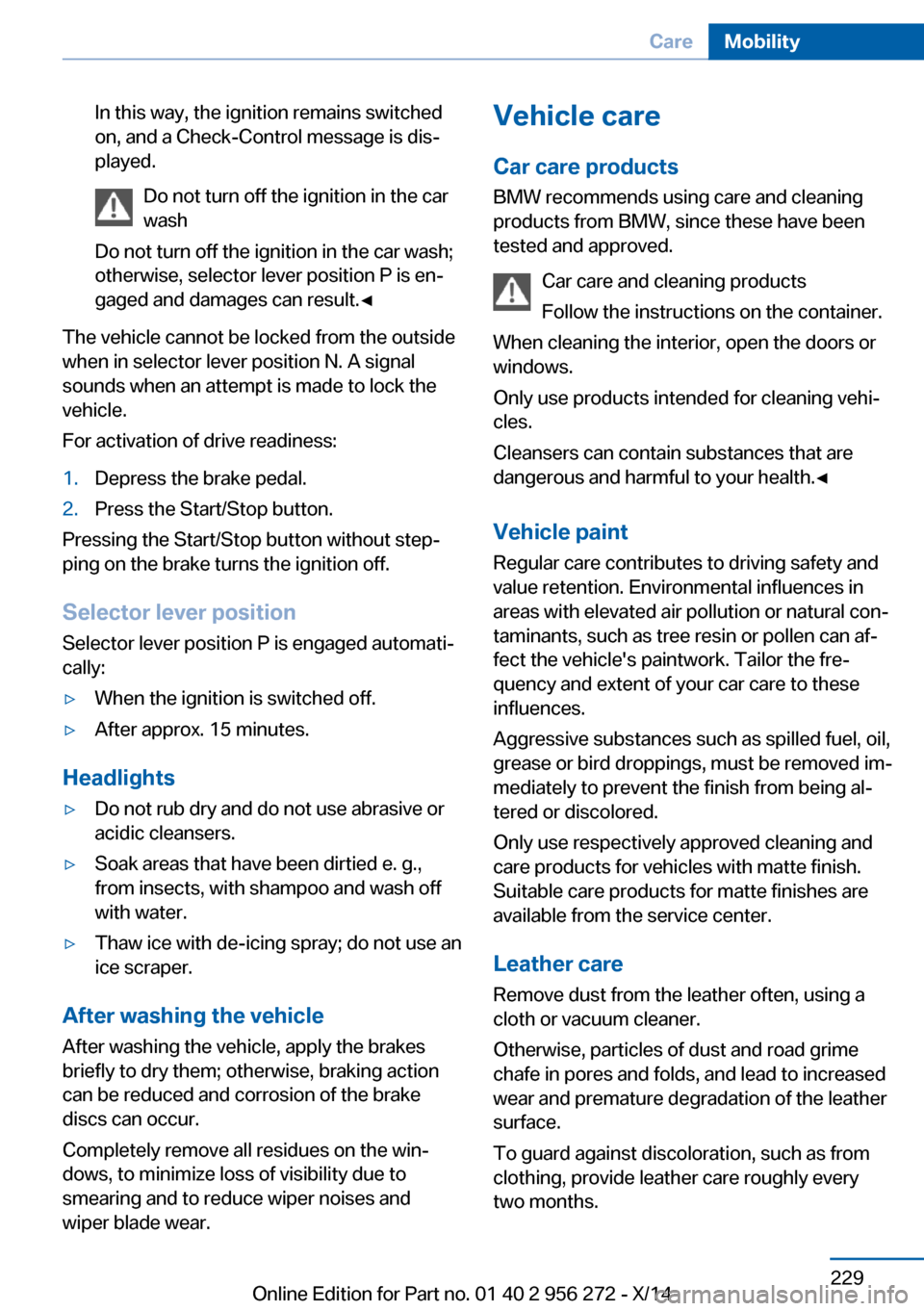
In this way, the ignition remains switched
on, and a Check-Control message is dis‐
played.
Do not turn off the ignition in the car
wash
Do not turn off the ignition in the car wash;
otherwise, selector lever position P is en‐
gaged and damages can result.◀
The vehicle cannot be locked from the outside
when in selector lever position N. A signal
sounds when an attempt is made to lock the
vehicle.
For activation of drive readiness:
1.Depress the brake pedal.2.Press the Start/Stop button.
Pressing the Start/Stop button without step‐
ping on the brake turns the ignition off.
Selector lever positionSelector lever position P is engaged automati‐
cally:
▷When the ignition is switched off.▷After approx. 15 minutes.
Headlights
▷Do not rub dry and do not use abrasive or
acidic cleansers.▷Soak areas that have been dirtied e. g.,
from insects, with shampoo and wash off
with water.▷Thaw ice with de-icing spray; do not use an
ice scraper.
After washing the vehicle
After washing the vehicle, apply the brakes
briefly to dry them; otherwise, braking action
can be reduced and corrosion of the brake
discs can occur.
Completely remove all residues on the win‐
dows, to minimize loss of visibility due to
smearing and to reduce wiper noises and
wiper blade wear.
Vehicle care
Car care productsBMW recommends using care and cleaning
products from BMW, since these have been
tested and approved.
Car care and cleaning products
Follow the instructions on the container.
When cleaning the interior, open the doors or
windows.
Only use products intended for cleaning vehi‐ cles.
Cleansers can contain substances that are
dangerous and harmful to your health.◀
Vehicle paint Regular care contributes to driving safety and
value retention. Environmental influences in
areas with elevated air pollution or natural con‐
taminants, such as tree resin or pollen can af‐
fect the vehicle's paintwork. Tailor the fre‐
quency and extent of your car care to these
influences.
Aggressive substances such as spilled fuel, oil,
grease or bird droppings, must be removed im‐
mediately to prevent the finish from being al‐
tered or discolored.
Only use respectively approved cleaning and
care products for vehicles with matte finish.
Suitable care products for matte finishes are
available from the service center.
Leather care Remove dust from the leather often, using a
cloth or vacuum cleaner.
Otherwise, particles of dust and road grime
chafe in pores and folds, and lead to increased
wear and premature degradation of the leather
surface.
To guard against discoloration, such as from
clothing, provide leather care roughly every
two months.Seite 229CareMobility229
Online Edition for Part no. 01 40 2 956 272 - X/14
Page 234 of 251
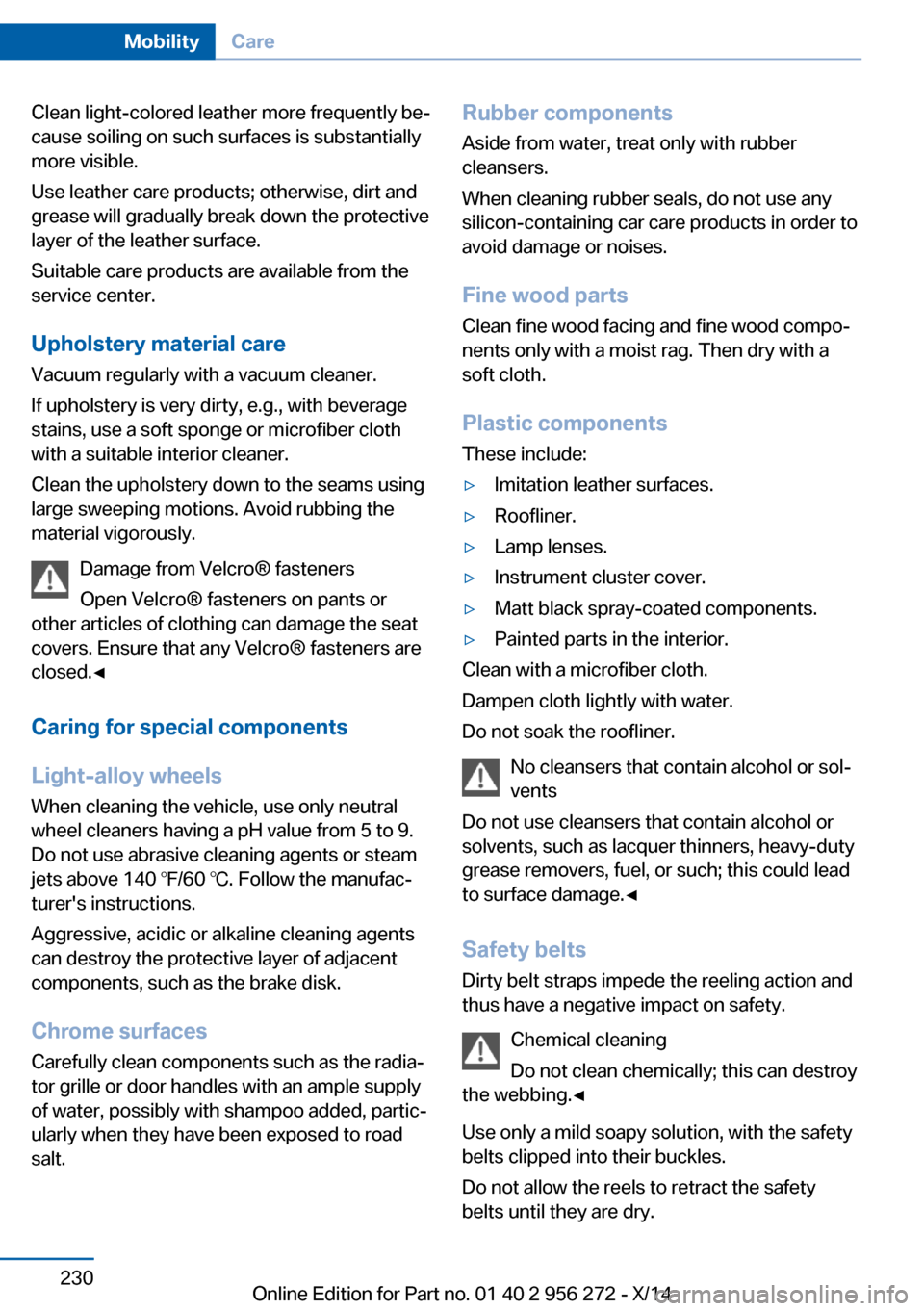
Clean light-colored leather more frequently be‐
cause soiling on such surfaces is substantially
more visible.
Use leather care products; otherwise, dirt and
grease will gradually break down the protective
layer of the leather surface.
Suitable care products are available from the
service center.
Upholstery material care Vacuum regularly with a vacuum cleaner.
If upholstery is very dirty, e.g., with beverage
stains, use a soft sponge or microfiber cloth
with a suitable interior cleaner.
Clean the upholstery down to the seams using
large sweeping motions. Avoid rubbing the
material vigorously.
Damage from Velcro® fasteners
Open Velcro® fasteners on pants or
other articles of clothing can damage the seat
covers. Ensure that any Velcro® fasteners are
closed.◀
Caring for special components
Light-alloy wheels When cleaning the vehicle, use only neutral
wheel cleaners having a pH value from 5 to 9.
Do not use abrasive cleaning agents or steam
jets above 140 ℉/60 ℃. Follow the manufac‐
turer's instructions.
Aggressive, acidic or alkaline cleaning agents
can destroy the protective layer of adjacent
components, such as the brake disk.
Chrome surfaces Carefully clean components such as the radia‐
tor grille or door handles with an ample supply of water, possibly with shampoo added, partic‐
ularly when they have been exposed to road
salt.Rubber components
Aside from water, treat only with rubber
cleansers.
When cleaning rubber seals, do not use any
silicon-containing car care products in order to
avoid damage or noises.
Fine wood partsClean fine wood facing and fine wood compo‐
nents only with a moist rag. Then dry with a
soft cloth.
Plastic components
These include:▷Imitation leather surfaces.▷Roofliner.▷Lamp lenses.▷Instrument cluster cover.▷Matt black spray-coated components.▷Painted parts in the interior.
Clean with a microfiber cloth.
Dampen cloth lightly with water.
Do not soak the roofliner.
No cleansers that contain alcohol or sol‐
vents
Do not use cleansers that contain alcohol or
solvents, such as lacquer thinners, heavy-duty
grease removers, fuel, or such; this could lead
to surface damage.◀
Safety belts
Dirty belt straps impede the reeling action and
thus have a negative impact on safety.
Chemical cleaning
Do not clean chemically; this can destroy
the webbing.◀
Use only a mild soapy solution, with the safety
belts clipped into their buckles.
Do not allow the reels to retract the safety
belts until they are dry.
Seite 230MobilityCare230
Online Edition for Part no. 01 40 2 956 272 - X/14
Page 235 of 251
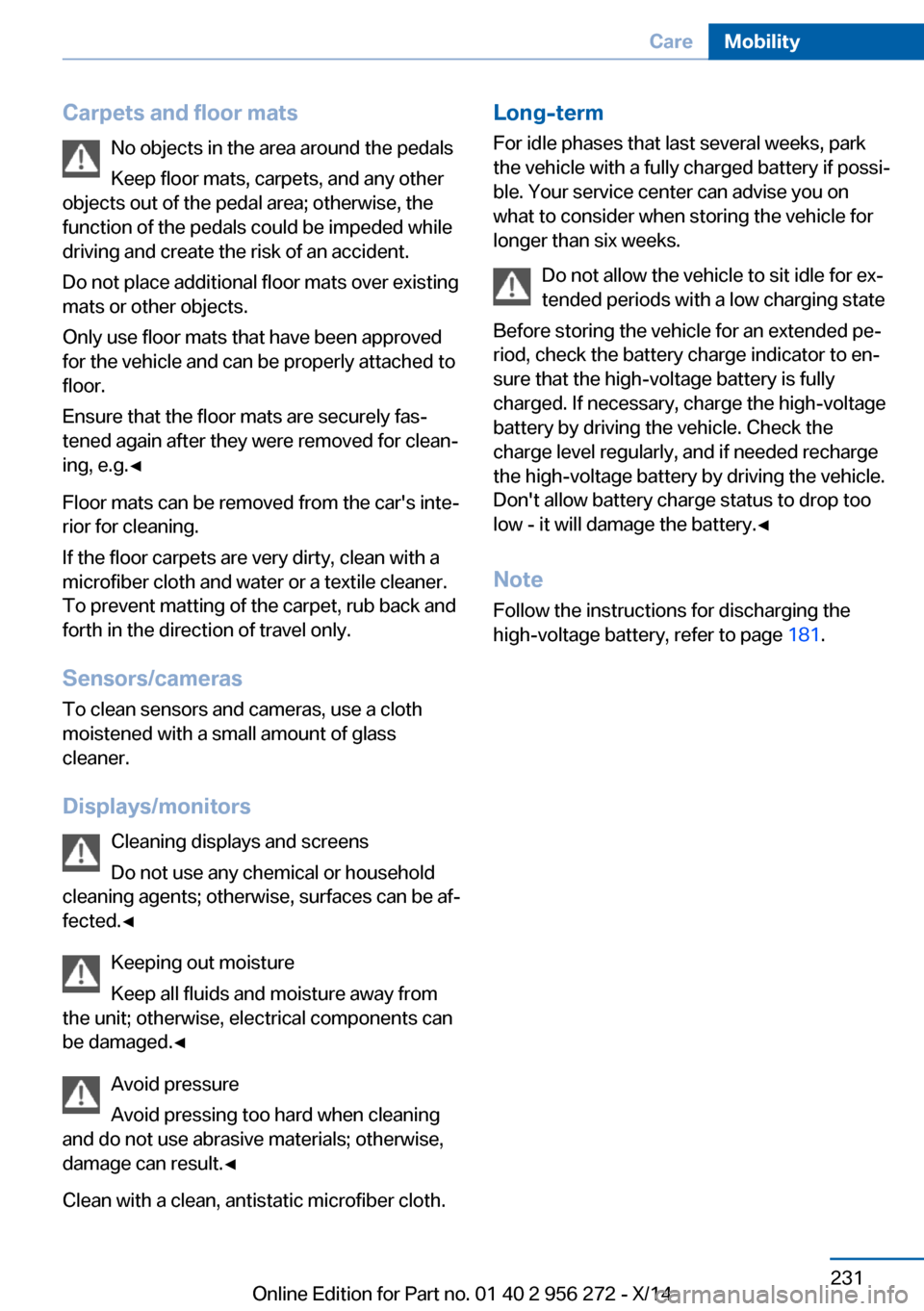
Carpets and floor matsNo objects in the area around the pedals
Keep floor mats, carpets, and any other
objects out of the pedal area; otherwise, the
function of the pedals could be impeded while driving and create the risk of an accident.
Do not place additional floor mats over existing
mats or other objects.
Only use floor mats that have been approved
for the vehicle and can be properly attached to
floor.
Ensure that the floor mats are securely fas‐
tened again after they were removed for clean‐
ing, e.g.◀
Floor mats can be removed from the car's inte‐
rior for cleaning.
If the floor carpets are very dirty, clean with a microfiber cloth and water or a textile cleaner.
To prevent matting of the carpet, rub back and
forth in the direction of travel only.
Sensors/cameras
To clean sensors and cameras, use a cloth
moistened with a small amount of glass
cleaner.
Displays/monitors Cleaning displays and screens
Do not use any chemical or household
cleaning agents; otherwise, surfaces can be af‐
fected.◀
Keeping out moisture
Keep all fluids and moisture away from
the unit; otherwise, electrical components can
be damaged.◀
Avoid pressure
Avoid pressing too hard when cleaning
and do not use abrasive materials; otherwise,
damage can result.◀
Clean with a clean, antistatic microfiber cloth.Long-term For idle phases that last several weeks, park
the vehicle with a fully charged battery if possi‐
ble. Your service center can advise you on
what to consider when storing the vehicle for
longer than six weeks.
Do not allow the vehicle to sit idle for ex‐
tended periods with a low charging state
Before storing the vehicle for an extended pe‐
riod, check the battery charge indicator to en‐
sure that the high-voltage battery is fully
charged. If necessary, charge the high-voltage
battery by driving the vehicle. Check the
charge level regularly, and if needed recharge
the high-voltage battery by driving the vehicle.
Don't allow battery charge status to drop too
low - it will damage the battery.◀
Note Follow the instructions for discharging thehigh-voltage battery, refer to page 181.Seite 231CareMobility231
Online Edition for Part no. 01 40 2 956 272 - X/14
Page 236 of 251
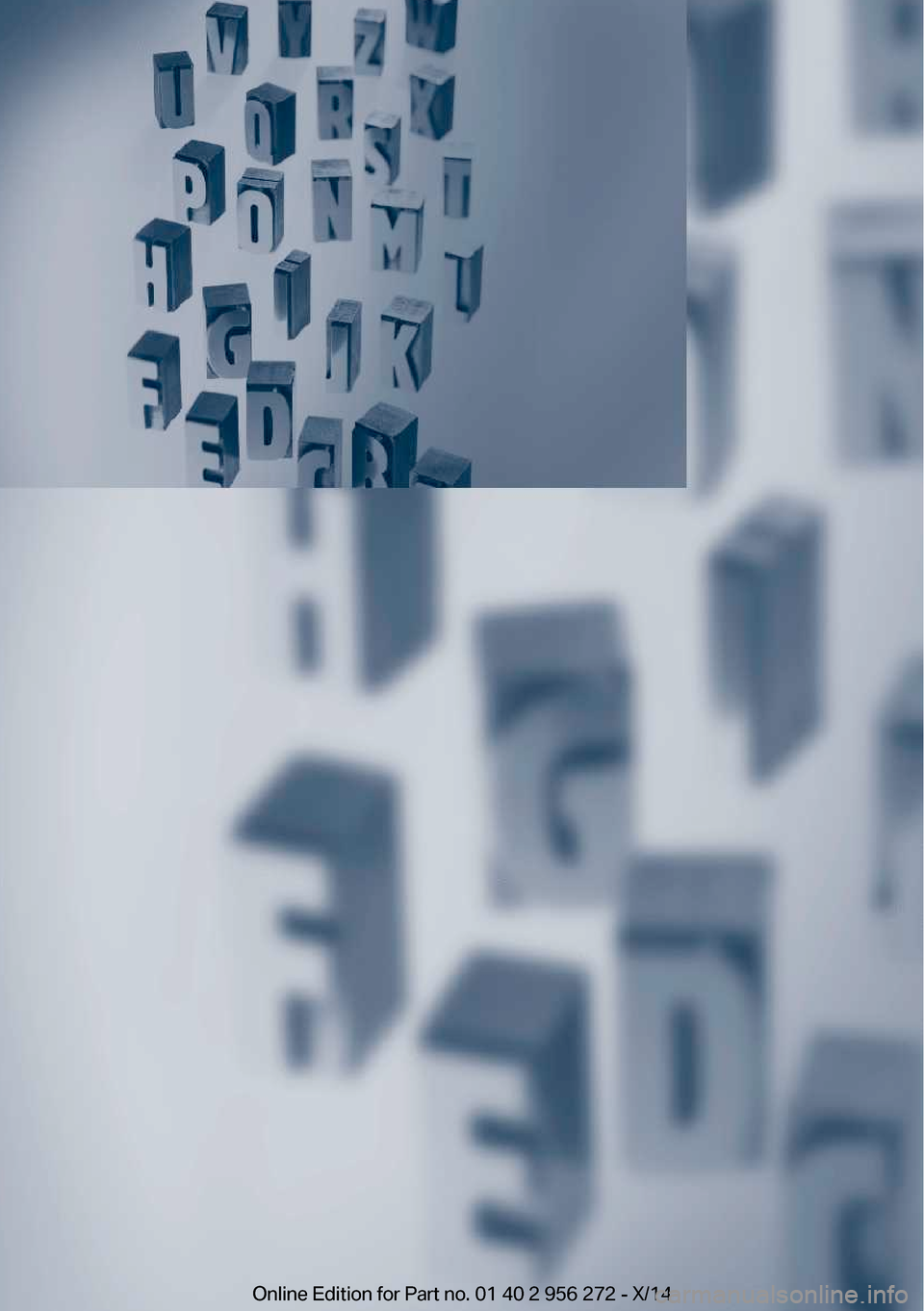
Online Edition for Part no. 01 40 2 956 272 - X/14
Page 237 of 251
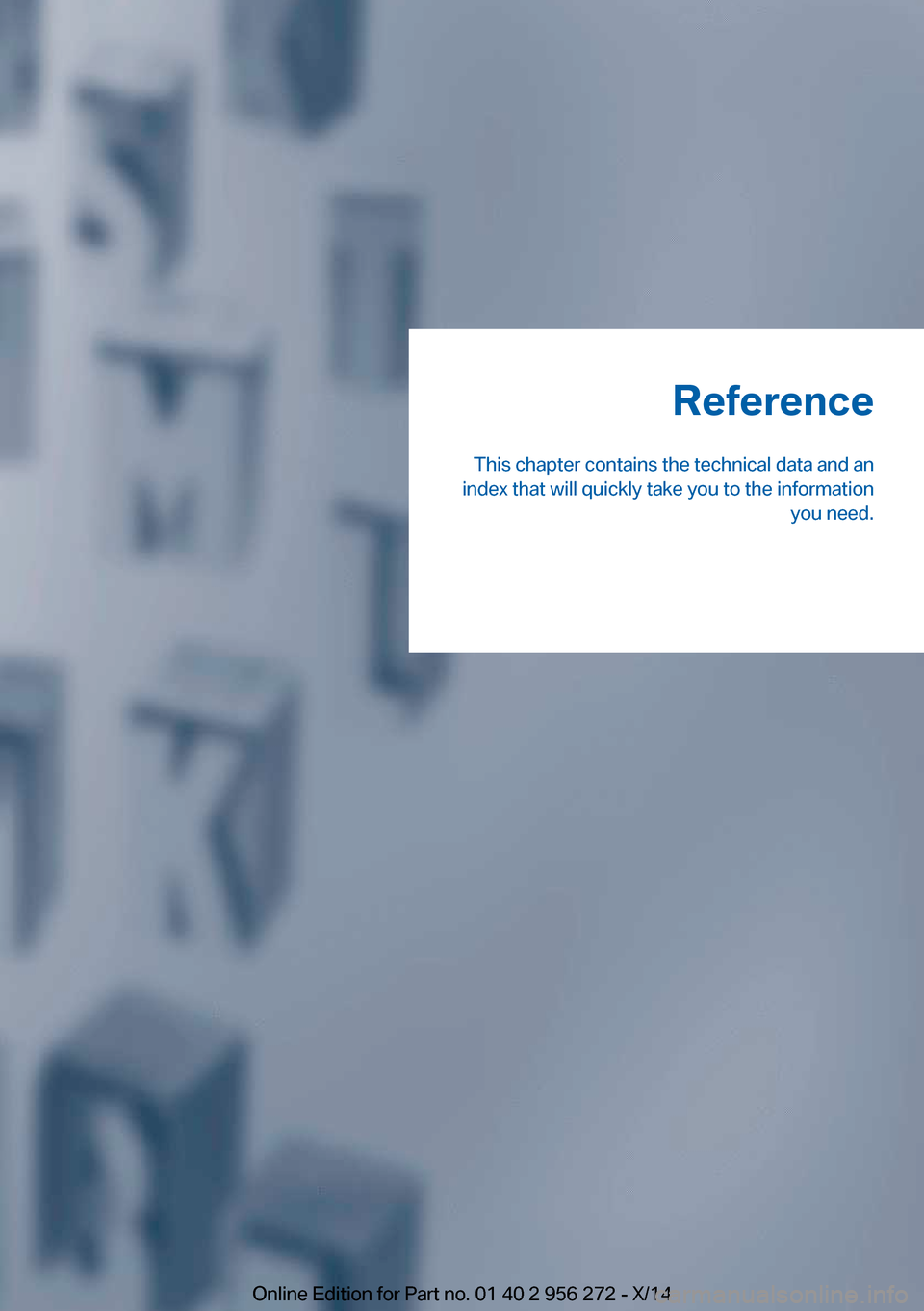
Reference
This chapter contains the technical data and an
index that will quickly take you to the information you need.Online Edition for Part no. 01 40 2 956 272 - X/14
Page 238 of 251
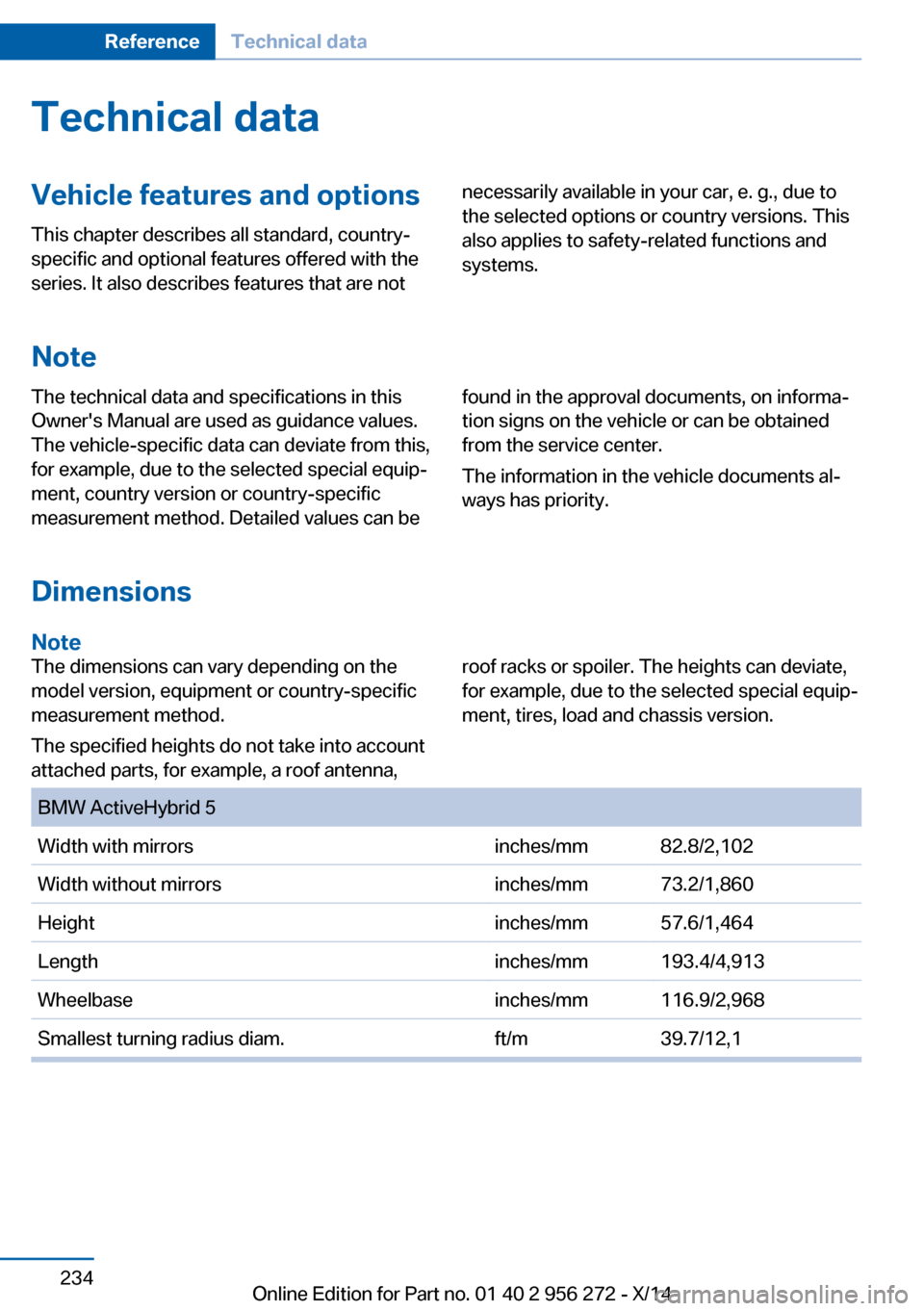
Technical dataVehicle features and options
This chapter describes all standard, country-
specific and optional features offered with the
series. It also describes features that are notnecessarily available in your car, e. g., due to
the selected options or country versions. This
also applies to safety-related functions and
systems.
Note
The technical data and specifications in this
Owner's Manual are used as guidance values.
The vehicle-specific data can deviate from this,
for example, due to the selected special equip‐
ment, country version or country-specific
measurement method. Detailed values can befound in the approval documents, on informa‐
tion signs on the vehicle or can be obtained
from the service center.
The information in the vehicle documents al‐
ways has priority.
Dimensions
Note
The dimensions can vary depending on the
model version, equipment or country-specific
measurement method.
The specified heights do not take into account
attached parts, for example, a roof antenna,roof racks or spoiler. The heights can deviate,
for example, due to the selected special equip‐
ment, tires, load and chassis version. BMW ActiveHybrid 5Width with mirrorsinches/mm82.8/2,102Width without mirrorsinches/mm73.2/1,860Heightinches/mm57.6/1,464Lengthinches/mm193.4/4,913Wheelbaseinches/mm116.9/2,968Smallest turning radius diam.ft/m39.7/12,1Seite 234ReferenceTechnical data234
Online Edition for Part no. 01 40 2 956 272 - X/14
Page 239 of 251
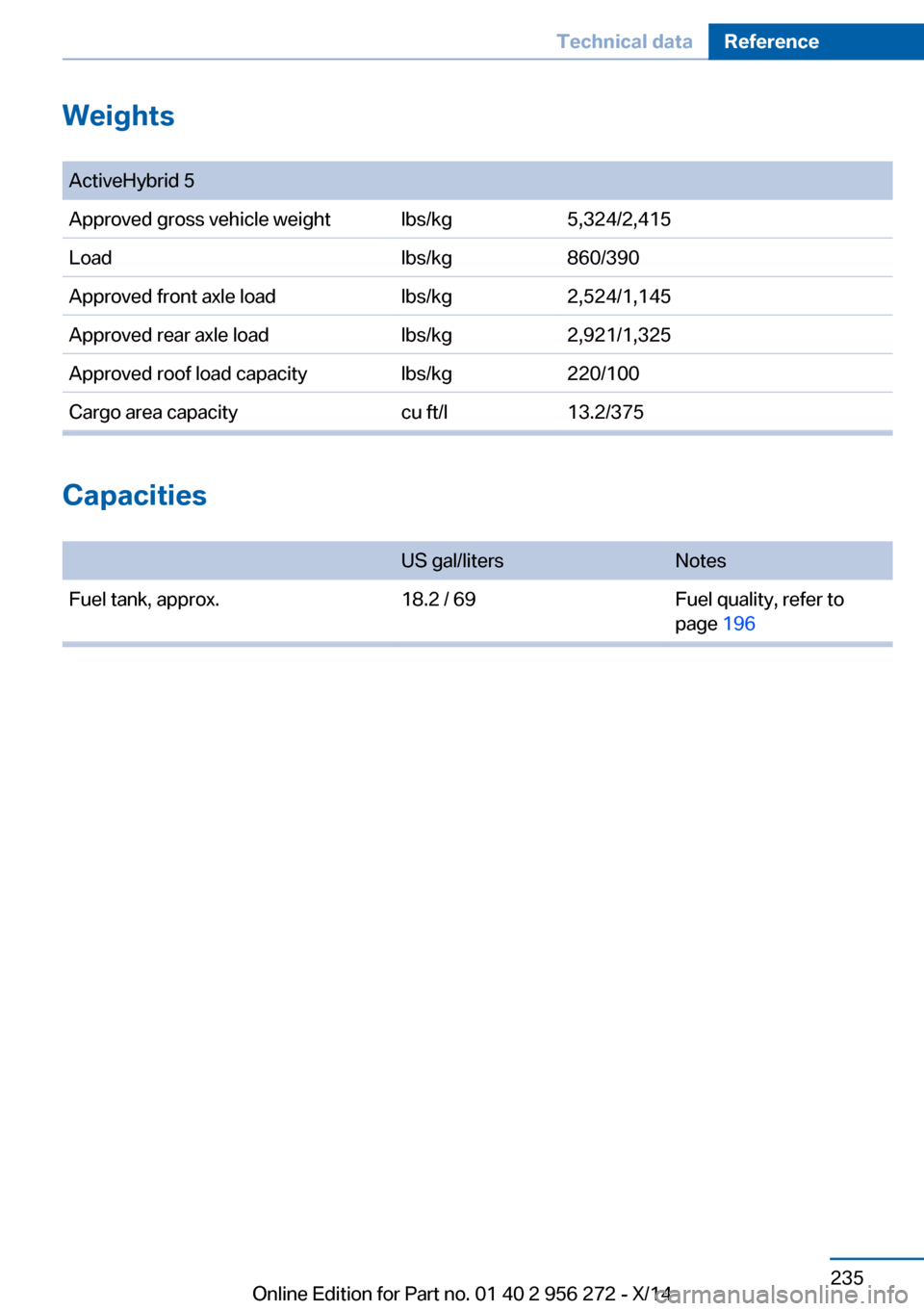
Weights
ActiveHybrid 5Approved gross vehicle weightlbs/kg5,324/2,415Loadlbs/kg860/390Approved front axle loadlbs/kg2,524/1,145Approved rear axle loadlbs/kg2,921/1,325Approved roof load capacitylbs/kg220/100Cargo area capacitycu ft/l13.2/375
Capacities
US gal/litersNotesFuel tank, approx.18.2 / 69Fuel quality, refer to
page 196Seite 235Technical dataReference235
Online Edition for Part no. 01 40 2 956 272 - X/14
Page 240 of 251
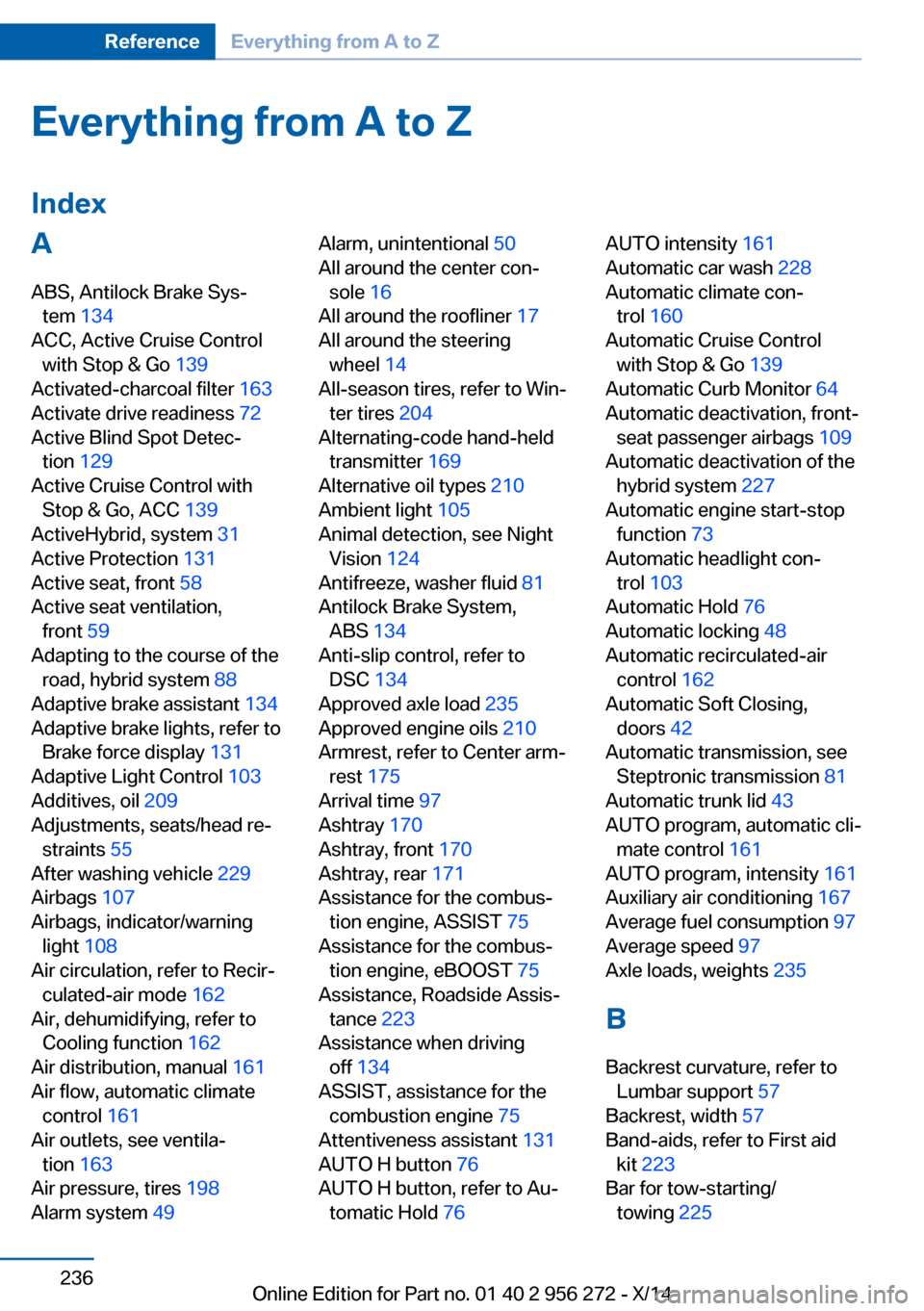
Everything from A to Z
IndexA ABS, Antilock Brake Sys‐ tem 134
ACC, Active Cruise Control with Stop & Go 139
Activated-charcoal filter 163
Activate drive readiness 72
Active Blind Spot Detec‐ tion 129
Active Cruise Control with Stop & Go, ACC 139
ActiveHybrid, system 31
Active Protection 131
Active seat, front 58
Active seat ventilation, front 59
Adapting to the course of the road, hybrid system 88
Adaptive brake assistant 134
Adaptive brake lights, refer to Brake force display 131
Adaptive Light Control 103
Additives, oil 209
Adjustments, seats/head re‐ straints 55
After washing vehicle 229
Airbags 107
Airbags, indicator/warning light 108
Air circulation, refer to Recir‐ culated-air mode 162
Air, dehumidifying, refer to Cooling function 162
Air distribution, manual 161
Air flow, automatic climate control 161
Air outlets, see ventila‐ tion 163
Air pressure, tires 198
Alarm system 49 Alarm, unintentional 50
All around the center con‐ sole 16
All around the roofliner 17
All around the steering wheel 14
All-season tires, refer to Win‐ ter tires 204
Alternating-code hand-held transmitter 169
Alternative oil types 210
Ambient light 105
Animal detection, see Night Vision 124
Antifreeze, washer fluid 81
Antilock Brake System, ABS 134
Anti-slip control, refer to DSC 134
Approved axle load 235
Approved engine oils 210
Armrest, refer to Center arm‐ rest 175
Arrival time 97
Ashtray 170
Ashtray, front 170
Ashtray, rear 171
Assistance for the combus‐ tion engine, ASSIST 75
Assistance for the combus‐ tion engine, eBOOST 75
Assistance, Roadside Assis‐ tance 223
Assistance when driving off 134
ASSIST, assistance for the combustion engine 75
Attentiveness assistant 131
AUTO H button 76
AUTO H button, refer to Au‐ tomatic Hold 76 AUTO intensity 161
Automatic car wash 228
Automatic climate con‐ trol 160
Automatic Cruise Control with Stop & Go 139
Automatic Curb Monitor 64
Automatic deactivation, front- seat passenger airbags 109
Automatic deactivation of the hybrid system 227
Automatic engine start-stop function 73
Automatic headlight con‐ trol 103
Automatic Hold 76
Automatic locking 48
Automatic recirculated-air control 162
Automatic Soft Closing, doors 42
Automatic transmission, see Steptronic transmission 81
Automatic trunk lid 43
AUTO program, automatic cli‐ mate control 161
AUTO program, intensity 161
Auxiliary air conditioning 167
Average fuel consumption 97
Average speed 97
Axle loads, weights 235
B Backrest curvature, refer to Lumbar support 57
Backrest, width 57
Band-aids, refer to First aid kit 223
Bar for tow-starting/ towing 225 Seite 236ReferenceEverything from A to Z236
Online Edition for Part no. 01 40 2 956 272 - X/14